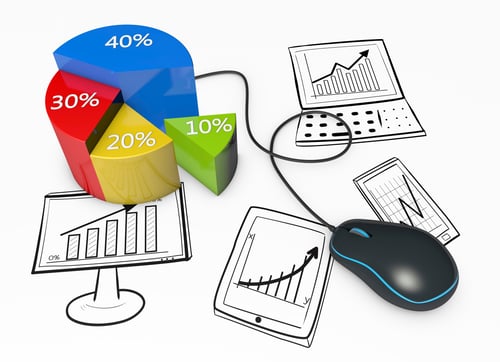I-Spy: Clues to See the Leads Generated by Your Website

Even some experienced business owners view website lead generation with a mixture of apprehension and confusion. It's strange to think that a person could simply visit your website and choose - or choose not - to enter your sales funnel.
confusion. It's strange to think that a person could simply visit your website and choose - or choose not - to enter your sales funnel.
However, this action is the basis of inbound marketing. To get the most out of your digital marketing strategy, you need to have a firm handle on how to tell where your leads are coming from and what you can do to nurture them along.
Since it can often feel like your website's visitors appear and disappear into thin air, it's critical to use performance indicators to pinpoint their source. In addition to identifying general lead sources, indicators of performance can also help you determine the source of the leads that make it all the way through your sales funnel. Certain indicators can even reveal the overall effectiveness of your lead nurturing and sales strategies.
With this information in your hands, you can figure out which types of leads you're great at cultivating - and where there might be room for improvement. The ultimate goal is a website that's optimized for conversions and an efficient digital platform that integrates seamlessly into your broader marketing operation.
Each of these seven important performance indicators can help you determine which leads come from your website as well as your overall efficiency at nurturing them through your sales funnel.
1. Total Website Traffic
Website traffic is arguably the most basic and important KPI. Without any traffic, your site wouldn't have a reason to exist.
Total website traffic is simply the number of visitors your site receives in a given time period. Depending on your needs, you can average this figure out over the course of a day, week, month or year. In most cases, website traffic figures are expressed as long-term averages. For instance, you might base your marketing strategies and growth plans on your site's average monthly visitor count over the course of a year.
Within this indicator, it's important to determine each visitor's source. Did they type in your URL, arrive from an organic search results page, click on a social media advertisement, respond to an email marketing campaign or come through some other means?
2. Bounce Rate
Even the best-designed websites can't please everyone. When a visitor leaves your site without taking any action, he or she is said to "bounce." The ratio of "bounced" visitors to total visitors is known as your bounce rate.
Generally speaking, your bounce rate should be as low as possible. Since bounce rate is a good proxy for site quality, you should work particularly hard to keep your rate lower than that of your competitors.
It's also important to remember that "bounced" visitors may not return to develop into leads. Therefore, any bounce represents a missed opportunity to generate a lead and potentially create a new sale.
3. Number of Leads Generated
Your "leads generated" indicator can be expressed as a raw number or a percentage: your lead generation rate. If your website isn't a lead-generating machine from the beginning, you shouldn't panic. Depending on your industry, your lead generation rate can be 1 to 3 percent and still support a healthy sales pipeline.
That being said, your website should be primed to generate leads that have a high likelihood of converting. Simplifying your website's navigation, including lots of product- or service-specific landing pages, making contact and information request forms easy to fill out and not requesting tons of information on standard forms are all great strategies for boosting your lead generation rate.
4. Lead Conversion Rate
Your lead conversion rate represents the proportion of generated leads that take the "next step" in your sales funnel. While such steps vary by company and industry, they might include responding to a sales email sent after receiving an initial contact form or scheduling an appointment with an in-house consultant, specialist or salesperson.
Like lead generation rates, lead conversion rates vary widely and may seem quite low. That said, you can boost your conversion rates by cultivating leads through multiple channels and personalizing sales contacts wherever possible.5. Sales Opportunities Generated
Sales opportunities vary widely in appearance, nature and stakes. Basically, a sales opportunity is any situation in which you have a clear opening to close the deal with a converted lead. For a B2C firm that sells products online, this might mean guiding your lead to your ecommerce portal's checkout page.
For a B2B firm that wishes to establish a long-term relationship with a new client, this might include a formal sales presentation or pitch. In either case, "sales opportunities generated" can be expressed as a raw figure or ratio of opportunities to converted leads.
6. Sales Close Rate
Your sales close rate is simply the number of actual sales divided by the number of sales opportunities. This is a key measure of your sales team's effectiveness. If you rely heavily on sales automation, it's a good indicator of that strategy's effectiveness as well.
7. Number of Sales
Your company's total website-attributable sales figure is an important measure of your website's effectiveness as a conversion tool and revenue driver. It's also important as a final reference point that ties back to your more basic lead generation metric: website traffic. While it might not be the holy grail of digital marketing metrics, your total-sales-to-total-traffic ratio is a key figure to keep in mind - and aspire to improve.
Put Your Key Performance Indicators to the Test
Taken together, these seven key performance indicators offer powerful insights into where your website leads come from. When used properly, this information can provide your company with a powerful competitive advantage over its peers.
After all, knowledge is power: If you know how visitors are reaching your digital doorstep, converting into actionable leads and moving further down the sales funnel, you're that much closer to knowing how to turn them into paying customers.






